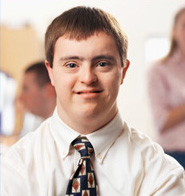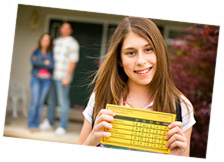All of the Following Are Challenges of Deaf-blindness That Teachers and Families Must Address Except
What should teachers understand in social club to address pupil multifariousness in their classrooms?
Page v: Exceptionalities
The term exceptionalities in Thou–12 schooling refers to both disabilities and giftedness. The Individuals with Disabilities Education Act '04 (IDEA '04), the national law that guarantees an appropriate education to students with disabilities, recognizes fourteen disability categories. These are:

- Autism
- Deaf-blindness
- Deafness
- Developmental delay
- Emotional disturbance
- Hearing impairment
- Intellectual disability
- Multiple disabilities
- Orthopedic damage
- Other health impairment
- Specific learning inability
- Oral communication or language impairment
- Traumatic brain injury
- Visual impairment, including blindness
x
intellectual disability
Replaces the term mental retardation and is the currently accustomed term.
x
free appropriate public education (FAPE)
A provision of Idea ensuring that students with disabilities receive necessary education and services without cost to the kid or family.
x
least-restrictive environment (LRE)
1 of the principles outlined in the Individuals with Disabilities Didactics Act requiring that students with disabilities be educated with their non-disabled peers to the greatest appropriate extent.
ten
related services
A part of special didactics that includes services from professionals (e.1000., occupational therapist [OT], physical therapist [PT], Oral communication-Linguistic communication Pathologist [SLP]) from a broad range of disciplines typically outside of instruction, all designed to meet the learning needs of private children with disabilities.
x
accommodations
A service or back up that allows a educatee to access the full general education curriculum without changing the content or curricular expectations (eastward.g., audio books for students who have difficulty reading).
ten
modification
A service or support that allows a student to access the general education curriculum only that fundamentally alters the content or curricular expectations (due east.g., a 6th-course student is given a tertiary-form science text nigh the solar system that covers the same content simply not at the aforementioned depth).
x
individualized teaching plan (IEP)
A written plan used to delineate an private student's current level of development and his or her learning goals, too as to specify whatever accommodations, modifications, and related services that a student might need to attend school and maximize his or her learning.
Most every general education classroom includes students with exceptionalities. Students with disabilities (ages 6–17) make up 11% of the total schoolhouse population. Of these students, three out of four spend all or part of their 24-hour interval in the general teaching classroom.
Why Exceptionalities Thing
 Unfortunately, misperceptions most students with exceptionalities go on to exist. Consider Angela and Robert, two students in a general didactics classroom. Angela has a learning disability and Robert has autism. Their instructor is surprised at how well Angela and Robert contribute to class discussions. Because Angela had problem reading, her instructor thought she would also struggle to understand the content. To the contrary, Angela learns quite well through other formats (e.grand., through discussion, auditorily), and her difficulties primarily involve written cloth. As well, the instructor expected that Robert would be nonverbal and have excessive disruptive behaviors, such equally rocking his body and flapping his easily. Instead, the merely behaviors of concern are his social skills, which are somewhat awkward. Robert'southward academic skills are at or above grade level.
Unfortunately, misperceptions most students with exceptionalities go on to exist. Consider Angela and Robert, two students in a general didactics classroom. Angela has a learning disability and Robert has autism. Their instructor is surprised at how well Angela and Robert contribute to class discussions. Because Angela had problem reading, her instructor thought she would also struggle to understand the content. To the contrary, Angela learns quite well through other formats (e.grand., through discussion, auditorily), and her difficulties primarily involve written cloth. As well, the instructor expected that Robert would be nonverbal and have excessive disruptive behaviors, such equally rocking his body and flapping his easily. Instead, the merely behaviors of concern are his social skills, which are somewhat awkward. Robert'southward academic skills are at or above grade level.
As is oftentimes the case, Robert and Angela's teacher focused on the stereotypical characteristics—especially negative ones—oftentimes associated with their disability labels. In fact, no two students with the same exceptionality act or achieve in exactly the aforementioned ways. It is important for teachers to learn about all aspects (due east.m., motivations, experiences, goals, strengths) of their students. Indeed, once Robert and Angela's instructor started learning more than about them, she discovered that—like most students—Angela and Robert take areas in which they succeed or excel besides every bit areas in which they need additional support. Understanding how a disability affects the student will allow teachers to make specific instructional adjustments.
Some of Ms. Christie's students appeared bored and uninterested; however, some of her students take disabilities which might contribute to their disengagement. Without the advisable instructional adjustments or supports, these students are unable to fully participate.
What Teachers Can Do
Teachers are non solitary in making specific instructional decisions for students with disabilities. A multidisciplinary squad develops an IEP for every student who receives special education services. These IEPs outline needed supports and services. The instructor tin can turn to members of this team, many of whom have specific expertise (e.g., special instruction, occupational therapy, assistive technology), to help her implement appropriate instructional techniques, interventions, and supports.
General educational activity teachers should be prepared to accost their students' broad range of ability levels and instructional needs. Ii approaches for helping them to do so—Universal Design for Learning (UDL) and differentiated pedagogy—are designed to meet the needs of the widest range of students (i.eastward., gifted, typically achieving, struggling learners, students with disabilities, ELLs). In the case of students with disabilities, their IEPs might outline more specific supports in the form of accommodations, modifications, or assistive technology. Click on the graphic for a cursory description of each.
x
Definitions
| assistive technology |
| Any device or service that helps an private with disabilities to access the full general education curriculum; examples include index cards to help a student track the line of text on a folio while he is reading (low-tech) and screen reading software that reads digital text aloud (loftier-tech). |
| accommodations or modifications |
| Accommodation: A service or support that allows a student to access the full general education curriculum without changing the content or curricular expectations (e.k., audio books for students who have difficulty reading). Modification: A service or support that allows a student with a inability to access the full general education curriculum but that fundamentally alters the content or curricular expectations (due east.yard., a sixth-grade student is given a 3rd-grade scientific discipline text to learn about the solar system––covering the same content simply not at the same depth). |
| differentiated instruction |
| An approach in which teachers vary and adapt didactics based on the individual needs of students in the classroom; examples of how to differentiate instruction include flexible group and immediate corrective feedback. |
| Universal Design for Learning (UDL) |
| A research-based framework for teachers to incorporate flexible materials, techniques, and strategies for delivering didactics and for students to demonstrate their knowledge in a diversity of ways. |
For boosted information about these areas view the following IRIS Modules:
- Universal Pattern for Learning: Creating a Learning Environment that Challenges and Engages All Students
- Differentiated Instruction: Maximizing the Learning of All Students
- Accommodations: Instructional and Testing Supports for Students with Disabilities
- Assistive Technology: An Overview
Ginger Blalock discusses some central considerations for students with disabilities.

Ginger Blalock, PhD
Professor Emeritus, Special Education Department
University of New United mexican states
Transcript: Ginger Blalock, PhD – Individualized instruction
Individualized instruction is taking the goals and objectives that the squad has identified as critical for a particular student and then putting them into play in the classroom. It may mean that a student has and needs certain modifications in either the materials or the content or the sequence of presentation, the mode that the instruction is delivered, or the manner that he or she demonstrates knowledge or competence. Individualized instruction may also hateful changing some goals and objectives so that the educatee only learns role of what other peers are learning, or information technology may mean in some instances that students participate in a unlike curriculum that may parallel the general curriculum merely that will get them closer to achieving the goals and objectives identified every bit critical for that item educatee. And so it means making changes to ensure that the kid doesn't have a cookie-cutter arroyo. It means designing instruction, carrying information technology out, and assessing information technology all along the mode to brand sure that students are progressing and learning what is most essential for him or her to learn. And you ever desire to fundamental that back to the general content standards and benchmarks that all peers are learning, but sometimes students need to also acquire additional or other skills.
Transcript: Ginger Blalock, PhD – Accessing the general instruction curriculum
Regarding the pedagogy of students with disabilities, their individual education program includes a statement of how the student will be supported in obtaining the almanac goals that the team decides is important. Every individual pedagogy plan has to besides include a statement nearly how the child will be involved in the general curriculum and actually progress in that full general curriculum, and also, related to LRE, how much the educatee will be educated and participate with students with and without disabilities. And this admission to the full general education curriculum is intended to exist with advisable modifications or supports or services that permit the student to be able to access the curriculum, to be able to learn from it, to exist able to demonstrate what they know, and to be able to be a role of that curriculum with their peers.
The reason why this provision is so important is because historically many students with disabilities who were in the general ed. settings, classroom or school were still denied access to that general ed. curriculum. There was a tendency for educators to say, "The student cannot learn this, and therefore we're non even going to bother. We'll just provide them with their own curriculum, or we'll unfortunately just kind of let them bide [their fourth dimension] and not really progress." And what this does is hogtie all the planners, all the folks on the team, to make sure that this student is participating as much every bit possible in what every other child is learning. And so one of the greatest means in which you see that facilitated is that now all planning that goes on for these students with disabilities must accost the regular content standards and benchmarks that every kid is learning at that grade level. And and so it but forces united states of america all to think about how tin can we help this child at least reach as much equally possible, in the aforementioned content, and the aforementioned skills that his or her peers are learning.
erlandsonnaal1948.blogspot.com
Source: https://iris.peabody.vanderbilt.edu/module/div/cresource/q2/p05/
0 Response to "All of the Following Are Challenges of Deaf-blindness That Teachers and Families Must Address Except"
Post a Comment